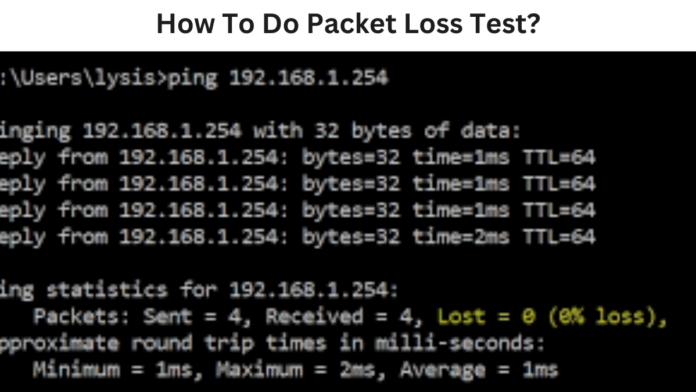Packet loss test can significantly impact your internet experience, causing slow loading times, buffering, and interruptions during video calls or online gaming. Testing for packet loss and assessing internet quality can help identify and resolve these issues.
Here is an article on how to do a packet loss test and check your internet quality.
What is the Packet Loss?
Packet Loss occurs when data packets travelling across a network fail to reach their destination. Network congestion, hardware issues, software bugs, or interference can cause it.
Common symptoms of packet loss include slow internet speeds, buffering videos, dropped calls, and lag in online games.
Tools for Packet Loss Testing
Some tools can help you test for packet loss and check your internet quality:
- Ping Command: A basic tool available on all operating systems.
- Traceroute Command: Identifies the path packets take and where loss occurs.
- Online Tools: Websites like PingPlotter, Packet Loss Test, and MySpeed provide easy-to-use interfaces for testing.
- Network Diagnostic Tools: Applications like Wireshark offer advanced network diagnostics.
How to use the Ping Command?
The ping command is a simple way to test for packet loss and measure latency.
On Windows:
- Press Win + R, type cmd, and press Enter.
- Type ping [IP address or domain] -n [number of packets] and press Enter. For example, ping google.com -n 100.
On Mac:
- Go to Applications > Utilities > Terminal.
- Type ping -c [number of packets] [IP address or domain] and press Enter. For example, ping -c 100 google.com.
Interpreting Results
The given are the results:
- Packets Sent/Received: Indicates the number of packets sent and received.
- Packet Loss Percentage: Shows the percentage of lost packets. Any loss above 1-2% can indicate a problem.
- Round-Trip Time (RTT): Measures latency. High RTT can indicate network congestion or issues.
Using the Traceroute Command
Traceroute helps identify where packet loss occurs along the route to a destination.
On Windows:
- Press Win + R, type cmd, and press Enter.
- Type tracert [IP address or domain] and press Enter. For example, tracert google.com.
On Mac:
- Go to Applications > Utilities > Terminal.
- Type traceroute [IP address or domain] and press Enter. For example, traceroute google.com.
Interpreting Results:
Here are the results:
- Hops: Each line represents a hop in the network path. Asterisks or high response times indicate potential issues.
- Response Times: Consistently high times or timeouts can pinpoint where the problem lies.
Using Online Tools
Online tools offer user-friendly interfaces for testing packet loss and internet quality.
PingPlotter
- Provides visual representations of packet loss and network performance.
- Visit the PingPlotter website and download the tool.
- Enter the target IP or domain and start the test. Analyze the results to identify issues.
Packet Loss Test
- A simple web-based tool for quick checks.
- Go to the Packet Loss Test website.
- Follow the instructions to start the test and review the results.
Using Network Diagnostic Tools
Advanced tools like Wireshark offer in-depth analysis of network traffic and packet loss.
- Visit the Wireshark website and download the application.
- Start a capture session and monitor network traffic.
- Use filters to identify packet loss and network performance issues.
Improving Internet Quality
After identifying packet loss or internet quality issues, take steps to improve your connection:
- Ensure all cables, routers, and modems are functioning correctly.
- Limit the number of devices using the network simultaneously.
- Keep your router and modem firmware up to date.
- Switch to wired connections instead of Wi-Fi to reduce interference.
- If issues persist, contact your Internet Service Provider for support.
Conclusion
Testing for packet loss and checking your internet quality is essential for maintaining a smooth online experience. By using tools like the ping and traceroute commands, online diagnostics, and advanced network tools, you can identify and resolve issues affecting your connection.
Regularly monitoring your network ensures optimal performance and minimises disruptions.
FAQs
What is packet loss?
Packet loss occurs when data packets travelling across a network fail to reach their end destination, causing slow speeds and disruptions.
How can I test for packet loss?
You can use tools like the ping and traceroute commands, online testing tools like PingPlotter, and network diagnostic applications like Wireshark.
What causes packet loss?
Network congestion, hardware issues, software bugs, or interference can cause packet loss.
How do I fix packet loss?
Check your hardware, reduce network congestion, update firmware, use wired connections, and contact your ISP if issues persist.
Is packet loss common?
Some packet loss is normal, but anything above 1-2% can indicate a problem that needs addressing.
Read More:















